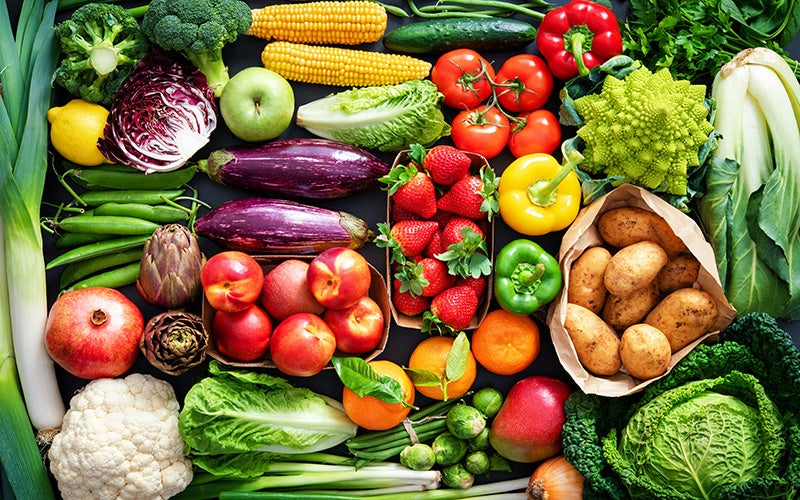Alkaline foods + acid-base balance
 © foodspring
© foodspring
Though you might have heard about the alkaline diet, you might not be so sure what it is. Basically, it ensures your body has a proper balance of acidic and basic (or alkaline) compounds, without which you could see a range of negative side effects, like acidosis — when your blood pH is too acidic — or alkalosis — when your blood pH is too alkaline. Luckily, all you have to do to find out whether you are eating enough alkaline foods is simply measure your body pH.
Body pH: How do you measure your acid-base balance?
Our body is made up of different fluids, each with a more or less acidic pH. Measuring its pH allows us to discover how alkaline or acidic the contents of our body may be. The pH can be acidic, basic or neutral:
- Between 0 – 6.9 is considered acidic.
- Between 7.1 – 14 is considered alkaline.
- A pH level of 7 is considered neutral.
The pH measurements will be different depending on the part of the body they’re taken from. In the stomach, for example, the pH will be very acidic because of the gastric acid that’s responsible for breaking down food during the digestion process.
In general, maintaining a pH between 7.35 and 7.45 is recommended. Below this range, it is possible to develop acidosis. And if it’s higher, you may develop alkalosis.
There are different methods to measure your body pH and some are more difficult than others. The simplest way is to obtain a pH test paper with which you can sample your urine to find out about your general pH balance. If you can’t find pH test papers and don’t feel unwell enough to make a trip to the doctor, focus on the foods you’re eating to ensure your acid-base balance is correct. Take a look at our article on balanced nutrition for a good starting point.
To make things even easier for you, we’ve based the information in this article on the PRAL (Potential Renal Acid Load) index of foods, which is a list of many different ingredients and their corresponding pH levels. Having this information readily available will make it easier for you to establish a diet that works for you. Of course, if you want to know exactly what’s going on with your pH levels and how to fix it, definitely check in with your doctor to get more information.
The best way to ensure you have a proper acid-base balance is to eat a diet full of fruits, vegetables, healthy fats, protein, complex carbohydrates, and fiber. If you have any doubts about your diet, our article on healthy eating will provide you with all the tips you need to eat healthy on a daily basis.
The alkaline diet
The goal of the alkaline diet is to maintain your acid-base balance on a day-to-day basis. Everyday, we eat a range of both alkaline and acidic, and our body does most of the work of balancing your acid-base level. When we eat a lot of acidic food, the reserves of alkaline compounds in our bodies automatically restores the balance. Excess acid is then excreted by our detoxifying organs. The kidneys, for example, eliminate the excess acid through our urine.
Eating the right balance of acidic and alkaline food is the best way to ensure your pH levels are balanced. For your reference, we’ve created a list of alkaline and acidic foods that you can use to adjust your current diet.
List of foods from the PRAL index
Eating a balanced diet is usually enough to ensure your acid-base levels are balanced, but how can you be sure?
By knowing which foods are acid-forming and alkaline-forming. Even though something may taste acidic and actually have an acidic pH level when measured on its own, the way it reacts in your stomach may cause it to form alkaline compounds. For example, a lemon may make you pucker, but it’s actually alkaline-forming once you’ve ingested it. On the other hand, the pH level of dairy products hovers in the neutral zone, but it will become acidic once ingested.
Obviously, it’s not easy to know what’s acidic and what’s alkaline just by looking at (or tasting) it, but there are ways to find out. To make it easier for everyone to differentiate, the PRAL index is used to measure how acidic or alkaline a food may be. Foods with a negative PRAL are alkaline, while food with a positive PRAL is acidic.

Most basic foods happen to be vegetables, which are also rich in vitamins and minerals. When you’re having trouble getting all the vitamins you need, though, our Daily Vitamins are a quick and easy way to get your daily dose.
your daily fruits & veg in a capsule
To give you a quick view of some basic and acidic foods, we’ve prepared this chart for you:
List of acidic and basic foods
| Food Group | PRAL index |
Drinks
| Red wine | -1.82 |
| Coffee | -1.40 |
| Cola | 1.75 |
| Unsweetened apple juice | -2.03 |
Grains and flour
| Spelt (whole-grain) | 7.50 |
| Whole-grain oats | 8.98 |
| Rice | 3.82 |
| White flour (type 405) | 4.98 |
Eggs and dairy products
| Eggs | 9.96 |
| Cream cheese | 0.90 |
| Swiss cheese (45% fat) | 21.54 |
| Low-fat milk | 0.39 |
| Whole milk plain yogurt | 0.05 |
Meat and cold cuts
| Chicken | 8.70 |
| Lean beef | 10.44 |
| Salami | 8.77 |
| Lean pork | 8.69 |
Fish and seafood
| King prawns | 18.20 |
| Herring | 9.18 |
| Salmon | 10.01 |
| Shrimp | 7.60 |
Vegetables
| Broccoli | -4.35 |
| Lamb’s lettuce | -6.62 |
| Cucumbers | -2.30 |
| Potatoes | -6.14 |
| Red peppers | -7.76 |
| Soy milk | -0.63 |
| Tofu | -0.33 |
| Tomatoes | -4.17 |
Fruit
| Bananas | -7.46 |
| Strawberries | -2.54 |
| Apples | -2.36 |
Fats and oils
| Butter | 0.49 |
| Margarine | -0.15 |
| Olive oil | 0.02 |
| Sunflower seed oil | -0.02 |
Sweet treats
| Dark chocolate | -11.45 |
| Milk chocolate | -1.30 |
| Ice cream | 2.26 |
| Chocolate-hazelnut spread | -1.94 |
Food too acidic? Here’s how to rebalance it with an alkaline diet
A diet rich in animal products (like dairy and meat) can often be too acidic for us. So can excessive consumption of sweets or industrial products containing preservatives and flavor enhancers.
Acidic pH levels can also be caused by stress, lack of sleep, or minimal exercise. In any case, a healthy and balanced diet is the only way to neutralize the excess of acidic compounds in our body.
If we don’t eat enough foods with alkaline pH levels, our body’s alkaline reserves will not be enough to neutralize the excess of acid for long. And that’s when some people start to develop acidosis, which can lead to other diseases down the line.
Eat basically
Make sure you give your body enough alkaline foods to avoid an imbalance. Have a look at our table below to see which foods can help you remove acidity. But in general, these ground rules apply:
- Fresh vegetables and fruit
- Dried fruit (unsulfured)
- Sprouts and herbs
- Smoothies (made from fresh fruit)
- Almonds, coconuts, chestnuts
- Herbal tea
Which foods alkalize?
These foods are particularly alkaline and can help your body with an imbalance.
| Cucumber | +31.5 |
| Soy sprouts | +29.5 |
| Dandelion | +22.7 |
| Avocado | +15.6 |
| Garlic | +13.2 |
| Sorrel | +11.5 |
| Fresh lemon | +9.9 |
| Chives | +8.3 |
Consequences of an acid-base imbalance in your diet
Many pathogens proliferate in an acidic environment, which means that you’ll be more likely to get sick if your acid levels are high. These are the most common symptoms you might experience:
- Fatigue and extreme exhaustion
- Headaches and difficulty concentrating
- Muscle and joint pain
- Heartburn and digestive issues
- Skin, nail, and hair problems
If your alkaline levels are too low, you may be more susceptible to infectious diseases and depression.
How can you reduce your acidity levels?
Eating a healthy, well-rounded diet is the best way to prevent acidosis and maintain your acid-base balance. The National Health Nutrition Programme (NHNP) recommends eating five servings of fruits and vegetables a day. In addition to maintaining your acid-base balance, they also contain many of the vitamins and minerals your daily diet needs. However, severe cases of acidosis should always be treated and diagnosed by a doctor.
Make your life even easier by whipping up a smoothie. Nutrient-rich and filling, it’s a perfect breakfast or snack, because it takes less than five minutes to make! Try our green power smoothie recipe as inspiration!
Overview of the different measures of body pH
If your acid levels are too high that’s usually not good for your health, but there are areas of the body where it’s perfectly normal to have more acid. Here, we take stock of which organs and fluids are acidic and which are alkaline.
- Pancreas
With a pH of 8.0, the pancreas is considered alkaline. Considering the pancreas is responsible for digesting food and regulating our blood sugar levels, this makes perfect sense. During the digestion process, the pancreas also neutralizes the acidic food you’ve consumed, and sends the waste to the small intestine, which also has a pH of 8.0.
- Saliva
The pH of our saliva should be between 7.1-7.0, which means it should be either alkaline or neutral. In severe cases of acidosis, gum and teeth damage can occur.
- Muscles
Our muscles and muscle cells have a pH of 6.9. This is because our muscles produce carbonic acid when they burn up our nutrients. The cells in every part of our body are constantly working to restore or maintain our acid-base balances and overall health. In fact, the heart, which is the hardest-working muscle in the body, stops beating if its acidity is too high (above a pH of 6.2).
- Urine
The pH of our urine can be more or less acidic, between about 4.8 and 8.0. Most of our excess acidity is evacuated in the urine.
- Gastric acid
Gastric acid has the lowest pH: between 1.2 and 3.0. It’s found in the stomach, and it’s composed of hydrochloric acid and pepsin. It dissolves the food you eat and it ensures that most of the pathogens you might ingest are killed.
In general, it’s better to have a slightly basic pH. A normal blood pH level is around 7.4 and is an ideal base for a good metabolic process.
In fact, the body keeps the acid-base balance mostly on its own. And in the event of irregularities, we all have a backup system that will keep you balanced. Like the respiratory system, which evacuates carbon dioxide, an acidic compound.
Alkaline foods: Our conclusion
Eating a balance of alkaline and acid forming foods is essential to maintaining our acid-base balances and overall health. While the pH levels of all our organs and fluids vary, they work together to create a balance that keeps you feeling well. In general, it’s better to have a slightly basic pH, although there are certain parts of the body where an acidic environment is actually preferable.
In order to evacuate excess acidity, we also have buffer systems in place that manage any imbalances or irregularities. The lungs, for example, will take care of evacuating carbon dioxide, through respiration.
Eating a healthy and balanced diet will ensure a good acid-base balance. And our products can help you get exactly what you need, no matter what your goals may be.
Our tip: our Vegan Protein is also rich in BCAAs and plant-based protein for a healthy, high-protein, meat-free diet.
If you’re interested in weight loss, don’t hesitate to check out our Body Check. In one click you will receive your recommended daily caloric intake, your BMI, and many other nutritional and weight loss tips.
Sources for this article
We at foodspring use only high-quality sources, including peer-reviewed studies, to support the facts within our articles. Read our editorial policy to learn more about how we fact-check and keep our content accurate, reliable, and trustworthy.

































